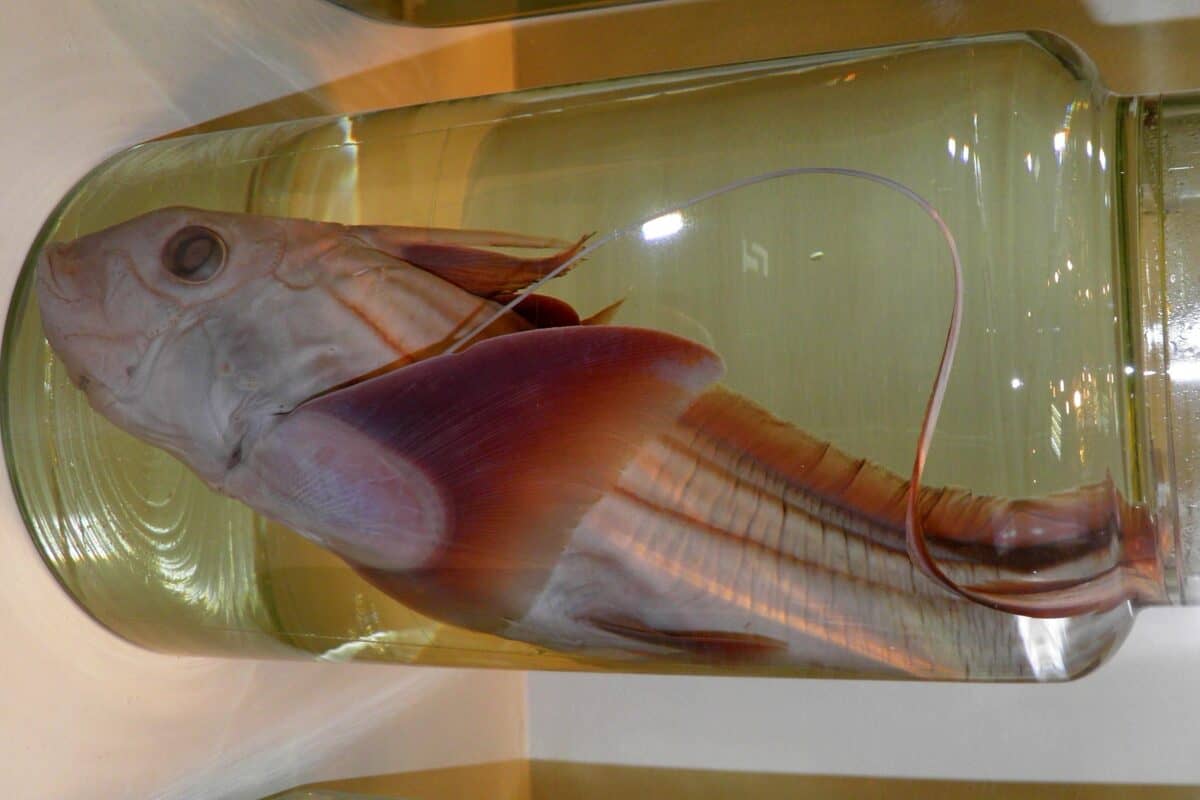The ocean, covering more than 70% of our planet, remains one of Earth’s greatest mysteries. While we’re familiar with common marine creatures like sharks, dolphins, and clownfish, the depths harbor bizarre species that seem to defy imagination. These unusual denizens of the deep have evolved extraordinary adaptations to survive in some of the most extreme environments on the planet. From fish with transparent heads to those that can walk on the ocean floor, these creatures showcase nature’s incredible diversity and creativity. Let’s dive into the strange world of 14 of the ocean’s weirdest fish that most people have never encountered or even heard about.
12. Barreleye Fish The Fish with a Transparent Head
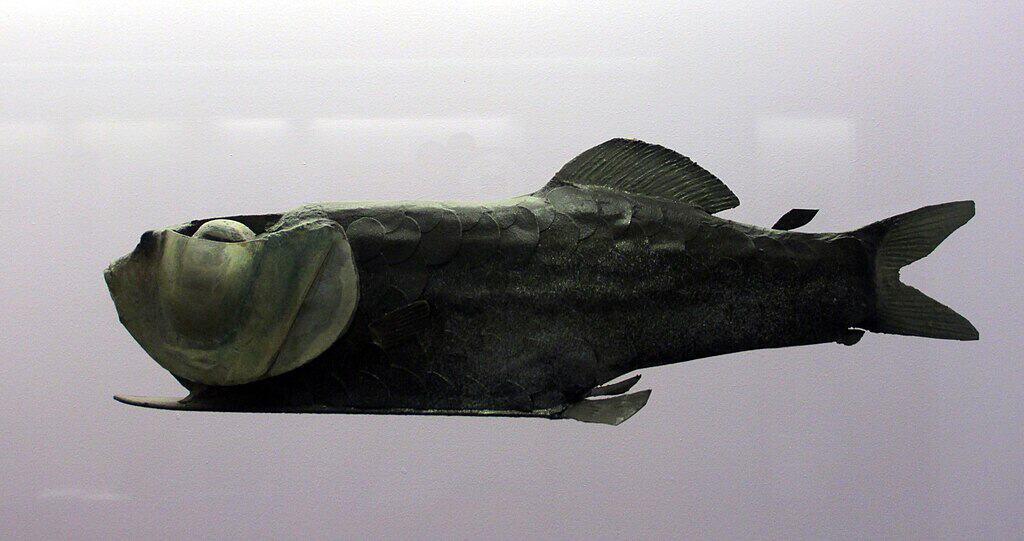
The barreleye fish (Macropinna microstoma) is perhaps one of the most alien-looking creatures in our oceans. Its most distinctive feature is its transparent, fluid-filled dome that covers its head, through which you can clearly see its tubular eyes. These specialized eyes are extremely sensitive to light and can rotate within the transparent shield, allowing the fish to look upward for potential prey or face forward when swimming.
Living at depths between 2,000 to 2,600 feet in the Pacific Ocean, barreleyes were first discovered in 1939, but their transparent heads weren’t known until 2004 when scientists observed live specimens. Their bodies are small, typically 6 inches long, with tiny fins and a small mouth. The barreleye’s bizarre anatomy serves a practical purpose – it can spot the silhouettes of potential prey against the dim light filtering from above, then adjust its position to capture food with remarkable precision.
11. Blobfish The World’s “Ugliest” Fish

The blobfish (Psychrolutes marcidus) gained internet fame after being voted the world’s ugliest animal in 2013. However, the gelatinous, saggy appearance we associate with this fish is actually a result of decompression damage. In its natural habitat—the deep waters off Australia and New Zealand at depths between 2,000 and 4,000 feet—the blobfish looks much more like a conventional fish with a more defined shape.
The blobfish’s body is primarily a gelatinous mass with a density slightly less than water, allowing it to float above the seafloor without expending energy on swimming. This adaptation is crucial for survival in the deep sea, where food is scarce and energy conservation is essential. The blobfish feeds by simply opening its mouth and letting edible matter float in. Despite their internet notoriety, very little is known about blobfish behavior or reproduction, as they’re rarely observed in their natural habitat.
10. Vampire Squid Not a Squid, Not an Octopus

Despite its name, the vampire squid (Vampyroteuthis infernalis, which literally means “vampire squid from hell”) is neither a squid nor an octopus but belongs to its own order. This deep-sea creature sports a dark red body, large blue eyes, and webbed arms that resemble a cape, giving it a vampiric appearance. When threatened, it can invert its cape-like webbing over its body, transforming into a spiky, defensive ball.
Living in the oxygen-minimum zones at depths of 2,000 to 3,000 feet, vampire squid have developed unique adaptations for their low-oxygen environment. They have the lowest metabolic rate of any non-hibernating animal, use hemocyanin to maximize oxygen extraction, and possess bioluminescent organs called photophores. Unlike their relatives, vampire squid don’t hunt or capture prey; instead, they collect marine snow (organic debris) using two long filaments and specialized cells that produce mucus to trap the particles. This ancient species has remained relatively unchanged for millions of years, serving as a living fossil in our oceans.
9. Frilled Shark A Living Fossil from the Deep

The frilled shark (Chlamydoselachus anguineus) looks like it swam straight out of prehistoric times—and essentially, it has. Often called a “living fossil,” this species has remained largely unchanged for 80 million years. With its elongated, eel-like body stretching up to 6.5 feet, a flattened head, and a mouth lined with 300 trident-shaped teeth arranged in 25 rows, the frilled shark is a formidable predator. Its name comes from the frilly appearance of its six gill slits that nearly encircle its throat.
This ancient shark typically inhabits the deep waters of the Atlantic and Pacific Oceans at depths of 390 to 4,200 feet. Its unusual body shape and low energy requirements allow it to hover motionless, waiting to strike passing prey. When hunting, the frilled shark can lunge forward like a snake to capture squid, fish, and even other sharks. Scientists rarely encounter these elusive creatures, and most of our knowledge comes from specimens accidentally caught in fishing nets. When discovered by fishermen or washed ashore, their primitive appearance often causes quite a stir in scientific communities.
8. Chimaera The Ghostly Rabbit Fish
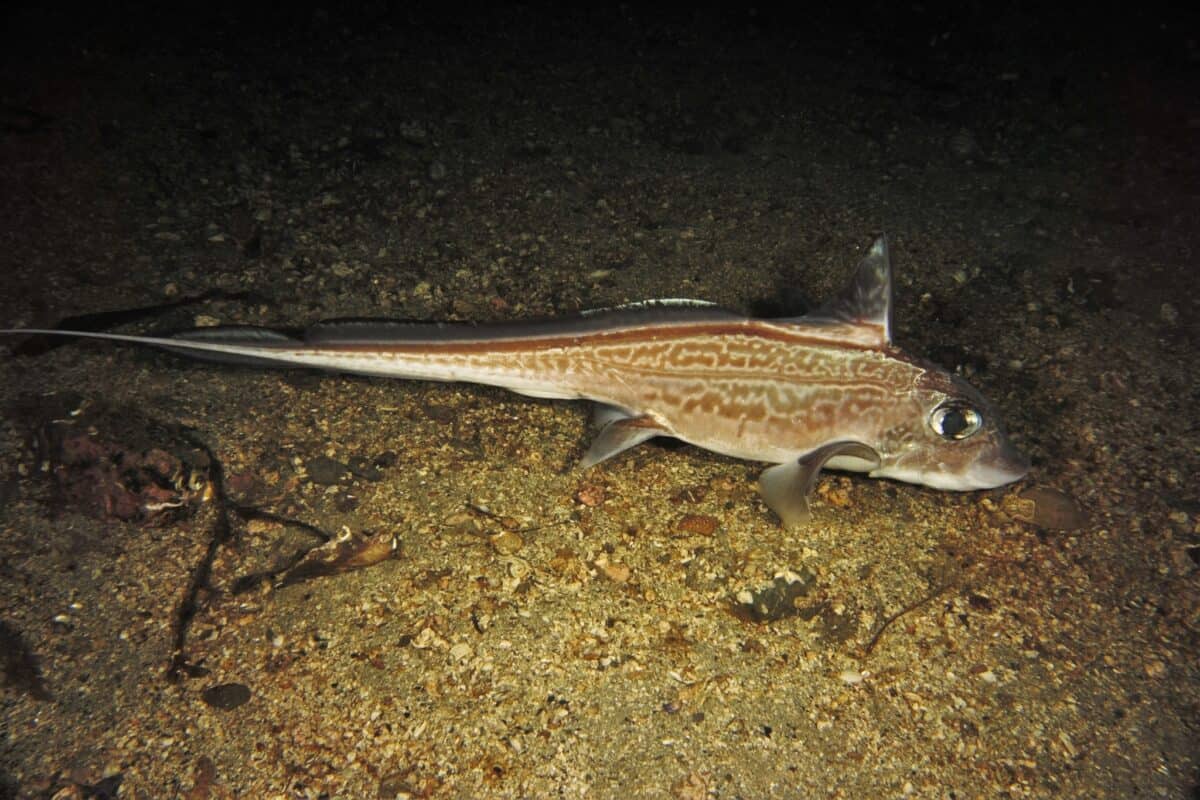
Chimaeras, also known as ghost sharks or rabbit fish, are some of the oldest living groups of fish, dating back 420 million years. Despite their nickname, they aren’t true sharks but belong to a separate subclass of cartilaginous fish. Their appearance is truly otherworldly—with large, greenish eyes that give them an eerie glow, smooth bodies lacking scales, and a peculiar rabbit-like face with a small mouth. Males possess a retractable sexual appendage on their head called a tenaculum, used to hold females during mating.
These mysterious creatures typically live at depths of 8,200 feet, gliding through the darkness using wing-like pectoral fins. Chimaeras detect prey using specialized sensory organs that can sense the electrical fields generated by other organisms. Their jaws are equipped with mineralized plates instead of teeth, perfect for crushing shellfish and crustaceans. While there are about 50 known species of chimaeras, their deep-sea habitat makes them difficult to study, and new species are still being discovered. Some species, like the spotted ratfish (Hydrolagus colliei), occasionally venture into shallower waters, providing rare opportunities for human observation.
7. Red-Lipped Batfish The Fish That Walks
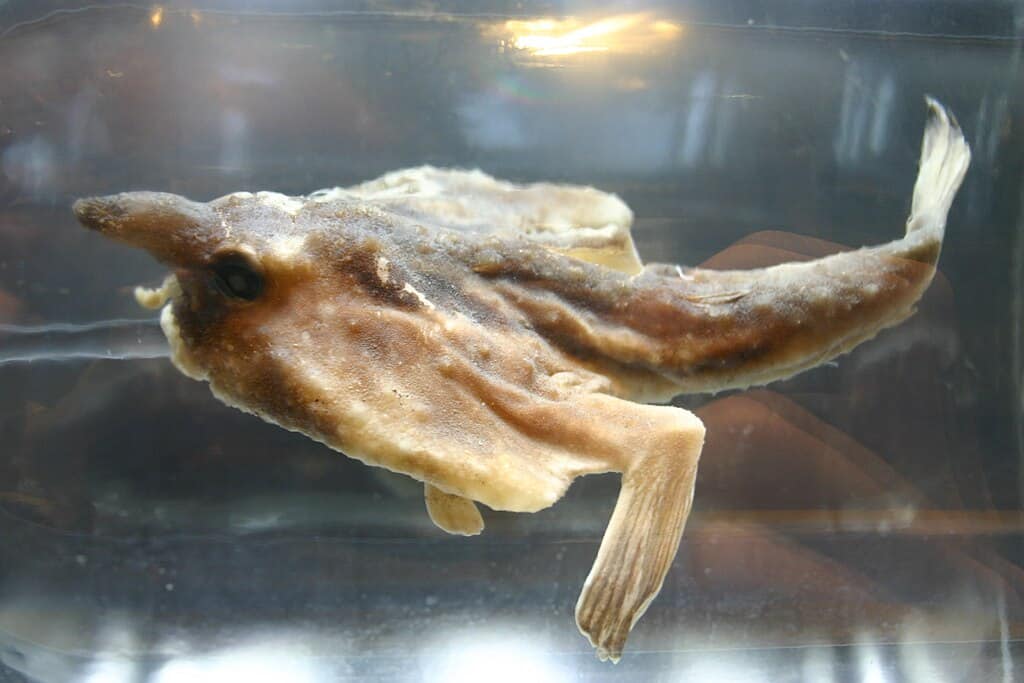
The red-lipped batfish (Ogcocephalus darwini) might be the ocean’s most glamorous oddity, sporting what appears to be bright red lipstick. Native to the Galápagos Islands, this unusual fish is characterized by its flattened body, pronounced “nose,” and those distinctive crimson lips that contrast sharply with its tan body. Scientists aren’t entirely sure about the purpose of the red lips, but they likely play a role in species recognition or attracting mates.
Unlike most fish, the red-lipped batfish isn’t a strong swimmer. Instead, it uses modified pectoral fins to “walk” along the ocean floor at depths of 10 to 250 feet. Young batfish can swim, but as they mature, their dorsal fin evolves into a spine-like projection called an illicium, which houses a modified fin ray known as an esca. This structure acts as a lure, producing chemicals that attract prey like small crustaceans and fish. The batfish’s unusual appearance and behavior make it a perfect example of the extraordinary adaptations that can evolve in isolated environments like the Galápagos.
6. Coffinfish The Deep-Sea Ambush Predator
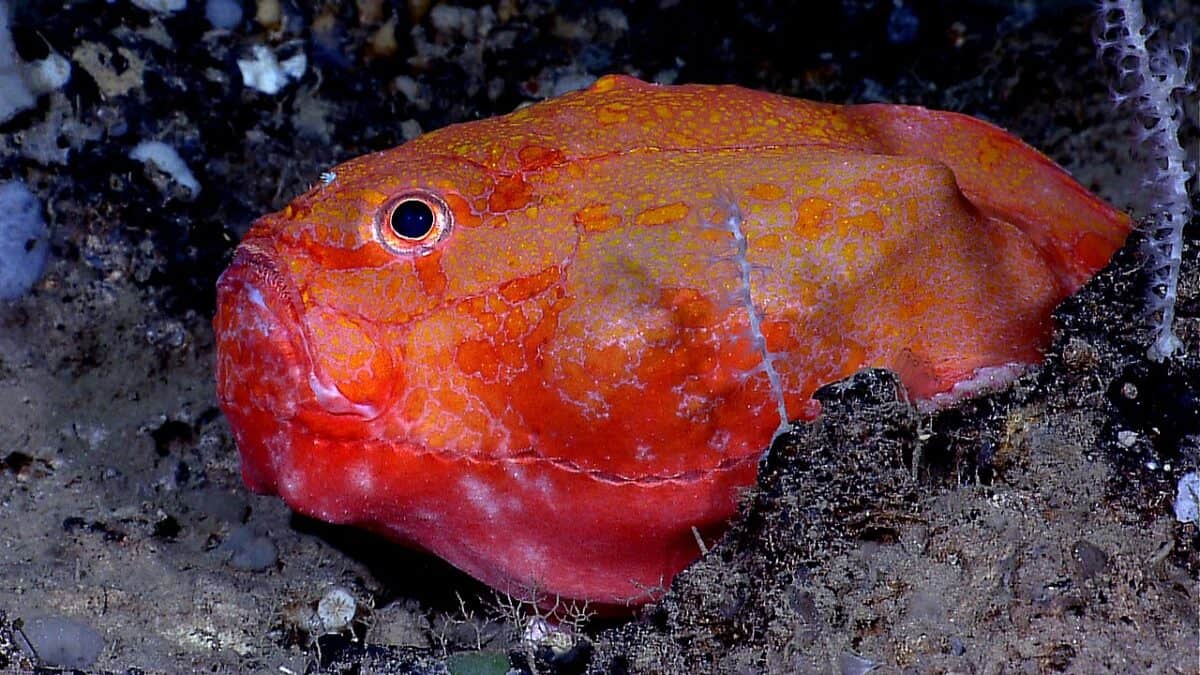
The coffinfish (genus Chaunax), a member of the anglerfish family, gets its morbid name from its boxy, coffin-shaped body. These bizarre bottom-dwellers inhabit deep waters worldwide at depths of 600 to 8,200 feet. They have a globular, somewhat flattened body covered in tiny spines and loose skin, giving them a wrinkled appearance. Their most distinctive feature is their ability to inflate themselves like a balloon when threatened, making them more difficult for predators to swallow.
Like other anglerfish, coffinfish are ambush predators that use a modified dorsal spine as a luring appendage. This fleshy lure, called an esca, extends from the head and can be wiggled to mimic a small creature, attracting curious prey within striking distance. When prey approaches, the coffinfish can expand its mouth with remarkable speed, creating a powerful suction that draws in the victim. Their sedentary lifestyle and mottled coloration, which ranges from reddish to yellowish-brown, help them blend perfectly with the seafloor. Some species have bioluminescent abilities, adding another tool to their predatory arsenal in the perpetual darkness of the deep ocean.
5. Viperfish The Deep-Sea Monster with Unmistakable Fangs

The viperfish (Chauliodus sloani) embodies our deepest fears about what might lurk in the ocean’s darkness. With a mouth full of enormous, transparent fangs too large to close its jaws around, the viperfish is a true deep-sea predator. These needle-like teeth, some as long as one-third of the fish’s head, are designed to effectively impale and trap prey. Their bodies are slender and can reach up to 12 inches in length, with metallic blue-green coloration that helps them remain camouflaged in the dim deep waters.
Living at depths between 650 and 5,000 feet, viperfish are equipped with photophores—light-producing organs that run along their sides and dorsal spines. They use these bioluminescent lights as lures, attracting prey in the darkness before launching lightning-fast attacks. During the day, viperfish typically remain in deeper waters, but at night they may migrate to shallower depths to hunt. Despite their ferocious appearance, viperfish are relatively small and have numerous predators, including dragonfishes and large deep-sea sharks. Their lifespan is surprisingly short for a deep-sea fish—typically around 15-30 years—and scientists believe they can go days or even weeks between successful meals.
4. Stoplight Loosejaw The Fish with a Built-in Flashlight
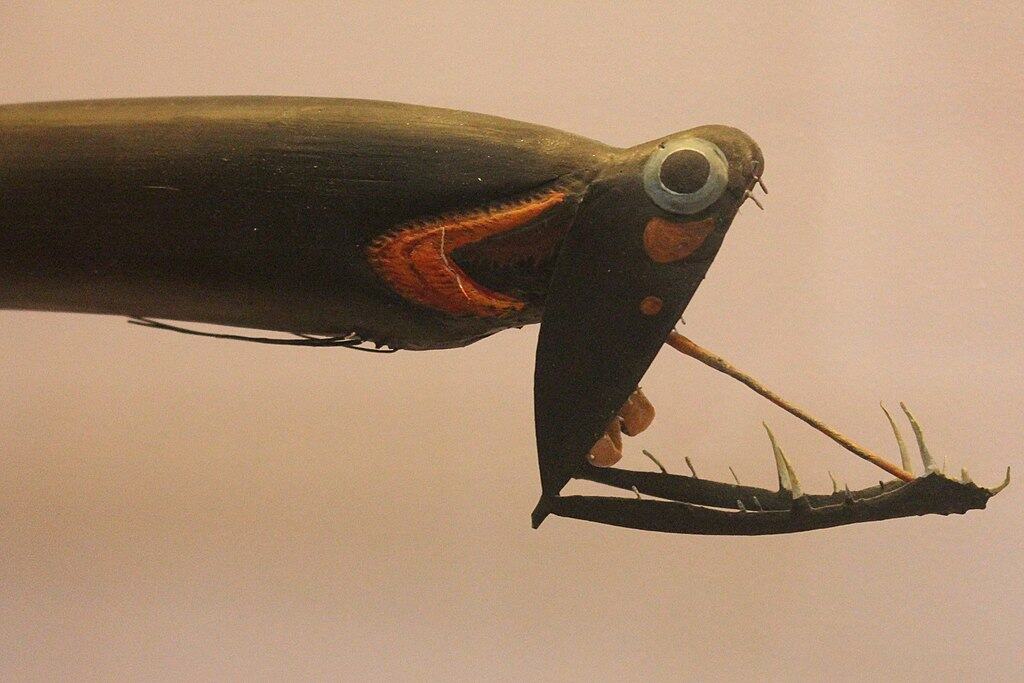
The stoplight loosejaw (Malacosteus niger) possesses one of the most sophisticated hunting systems in the deep sea. This small fish—usually less than 10 inches long—is named for its unusual jaw structure, which lacks a floor and is connected to the skull by a hinge and a pair of elastic ligaments. This modification allows it to open its mouth extremely wide and snap it shut with lightning speed. But what truly sets this fish apart is its advanced bioluminescent system.
Unlike most bioluminescent creatures that produce blue-green light, the stoplight loosejaw is one of only three fish known to produce red light as well. It has a large photophore under each eye—one producing blue-green light (the “stoplight”) and the other producing red light. This red light is invisible to most deep-sea creatures, whose eyes have evolved to detect only the blue-green spectrum that penetrates deeper waters. The loosejaw essentially has a “secret flashlight” it can use to spot prey without being detected. This sophisticated adaptation gives it a significant hunting advantage in the darkness of the deep ocean, where it typically lives at depths between 1,600 and 3,300 feet.
3. Gulper Eel The Fish That’s All Mouth

The gulper eel (Eurypharynx pelecanoides), also known as the pelican eel, is named for its most distinctive feature—an enormous mouth that’s much larger than its body. This deep-sea oddity can stretch its jaw to create a massive pouch-like lower portion, similar to a pelican’s bill, allowing it to swallow prey much larger than itself. Its body is extremely thin and black, stretching up to 6 feet long, though most of this length is its whip-like tail that ends in a light-producing organ used to attract prey.
Living at depths between 3,000 and 6,000 feet, gulper eels have tiny eyes that provide limited vision in the dark ocean depths. They rely more on their large, sensitive lateral line system to detect movement and vibrations in the water. Unlike many deep-sea predators that conserve energy by waiting for prey, gulper eels are believed to be more active hunters, swimming with their enormous mouths wide open. When prey—typically crustaceans, small fish, or cephalopods—enters their cavernous jaws, the eel’s mouth snaps shut, trapping the victim. Due to their extreme habitat, gulper eels are rarely seen alive, and much of what we know comes from specimens caught in deep-sea trawling nets.
2. Pacific Blackdragon The Ultra-Black Deep-Sea Predator
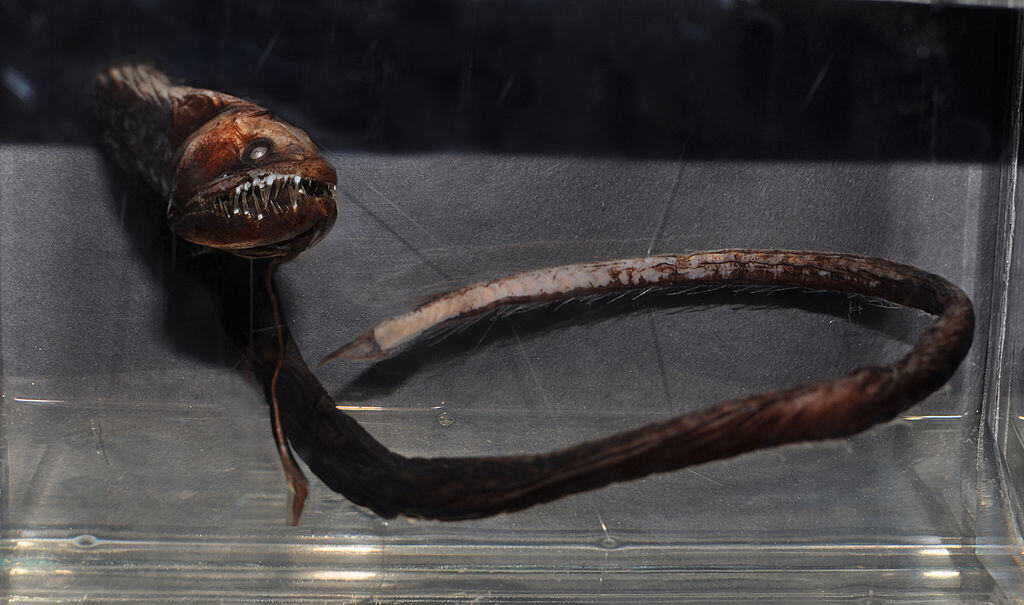
The Pacific blackdragon (Idiacanthus antrostomus) is a master of stealth, possessing one of the darkest natural materials known. Its skin absorbs over 99.5% of light that hits it, making it nearly invisible in the deep sea. This remarkable adaptation is achieved through a layer of tightly packed pigment cells combined with a unique arrangement of melanosomes (pigment-containing structures) that trap and absorb nearly all light. Female blackdragons can grow up to 2 feet long, while males are much smaller at only about 2 inches and lack functional digestive systems, existing solely to reproduce.
Beyond its ultra-black camouflage, the Pacific blackdragon has several other bizarre adaptations. Females possess a barbel (a whisker-like sensory organ) extending from their chin that produces light to attract prey. They also have enormous teeth and expandable jaws lined with sharp, fang-like teeth. Perhaps most remarkably, their eyes are not on their head but at the end of long stalks, giving them enhanced peripheral vision to spot bioluminescent prey. These eyes are tubular and point upward, allowing them to detect silhouettes against the faint light from the surface. Living at depths between 2,000 and 9,000 feet, blackdragons are among the most perfectly adapted deep-sea predators, combining stealth, specialized sensory equipment, and efficient hunting capabilities.
1. Telescopefish The Fish with Tubular Eyes
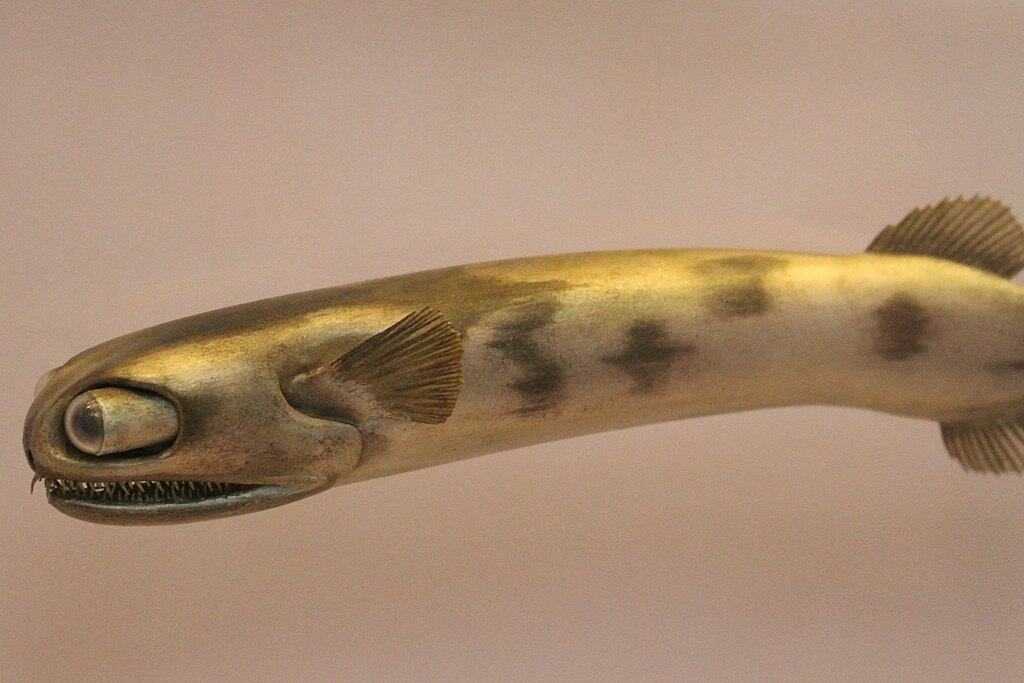
The telescopefish (family Giganturidae) is named for its most distinctive feature—enormous, tubular eyes that protrude from its head like telescopes. These specialized eyes, which can be up to 5% of the fish’s total body length, are among the most sensitive in the animal kingdom, capable of capturing even the faintest light in the deep sea. The two known species—Gigantura indica and Gigantura chuni—have translucent bodies ranging from 6 to 12 inches long, with large mouths and tiny fins.
What makes telescopefish particularly unusual is their hunting strategy. Unlike many deep-sea predators that use lures, telescopefish are active hunters that rely on their exceptional vision to spot prey from a distance. Their tubular eyes allow them to see in extremely low-light conditions and can detect even the slightest movements or bioluminescent flashes. Once prey is spotted, the telescopefish uses its large mouth and expandable stomach to consume surprisingly large meals. They’ve been observed with prey items nearly as large as themselves in their stomachs. Living at depths of 1,600 to 6,500 feet, telescopefish represent an evolutionary path that prioritized vision over other sensory systems, resulting in one of the most bizarre-looking fish in the ocean.
Conclusion:

The ocean is home to some of the planet’s most bizarre and fascinating creatures, many of which remain unknown to most people. The 12 fish highlighted in this article showcase nature’s boundless creativity—from fish that generate their own light to those with transparent heads, fang-like teeth, or even the ability to walk on land. These unusual species have evolved in extreme environments, adapting in ways that often seem more like science fiction than science fact.
Yet beyond their strangeness lies a deeper significance. Each of these fish plays a role in its ecosystem, contributing to the balance of life in the ocean’s depths, reefs, and coastal waters. As we continue to explore the seas, we not only uncover more of these marvels but also gain insight into the incredible diversity and resilience of marine life. In a time of environmental change, understanding and protecting these weird and wonderful creatures has never been more important.
- 15 Things You Did Not Know About Owl Eyes - August 7, 2025
- 15 Times Rescue Animals Proved They Are the Best Companions - August 7, 2025
- 14 Signs Animals Experience Joy - August 7, 2025

